SOWING PEARS AND LETTUCES
/19 Comments/in Gardening/by Lee ReichFor the Long Haul
Among the must-have tools for any good gardener are hope, optimism, and patience. I thought of all three last week as I was planting some seeds.
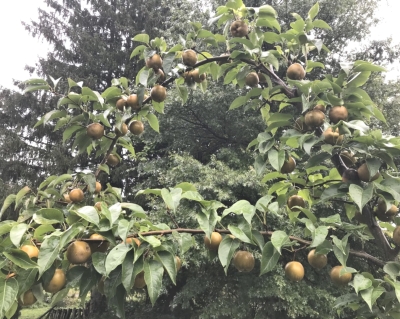
The first of these seeds especially emphasizes patience. They were a few pear seeds I saved from pears I had eaten. After being soaked for a couple of days in water, the cores were soft enough for the seeds to be squeezed out, after which they were rinsed, and then planted in potting soil.
I put the planted seeds near a bright window in my basement where the cool (about 40°) temperatures would, in a couple of months, fool the seeds into feeling that winter was over. They would sprout.
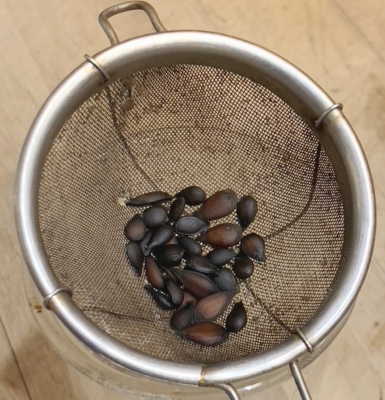
Given time, those seeds would grow to become pear trees and, given more time (ten years, possibly more) go on to bear fruit. Those seeds came from Bosc and Passe Crassane pears. The genetics of the resulting trees will represent the sexual union of egg cells within the flowers with whatever male pollen happened to fertilize those eggs. As a result, said trees would bear fruits different, and probably worse, than the fruits from which they were taken. (There’s less than 1 in 10,000 chance of a seedling apple tree bearing fruit as good or better than the fruit from the mother tree; the ratio for pears should be similar.)
Shortening the Long Haul, and Other Benefits
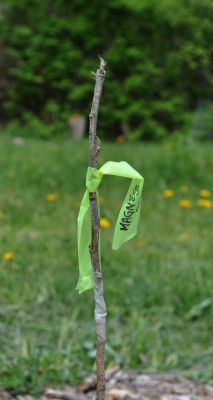
Grafted tree, this one NOT interstem
So why will I be wasting all that time nurturing these plants? Because they’re not for fruit. They’re for rootstocks, for grafting. Pears and most other tree fruits are very hard to root from cuttings, so are propagated by grafting a stem of a good-tasting pear low on a rootstock.
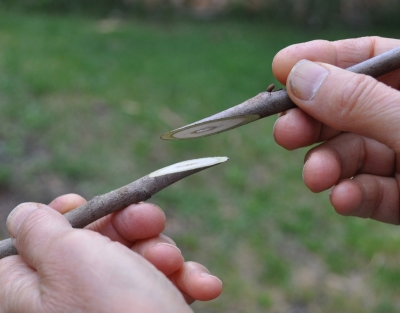
So-called “seedling” rootstocks make for very sturdy trees, well anchored and genetically diverse so some scourge can’t wipe out a whole bunch of equally susceptible, genetically identical trees. On the other hand, seedling rootstocks make for very large trees that are very slow to induce bearing in their grafted portions.
Enter from stage right: clonal rootstocks, that is, plants reproduced asexually (cuttings are one example of asexual plant propagation) so that all members of the clone are genetically identical. Some clonal pear rootstocks — with such unalluring names as Pyrodwarf and OH x F 87 — have been developed that make smaller grafted trees that also are quicker to come into bearing. (I delve more deeply into the nitty gritty of grafting in my book The Ever Curious Gardener: Using a Little Natural Science for a Much Better Garden.)
My plan is to make interstem trees, each one by grafting a 9 inch stem of one of the clonal rootstocks near the base of a seedling rootstock, and then some variety for eating, such as Passe Crassane, atop the clonal interstem. That 9 inch clonal interstem has the same good effects as if it was used as a rootstock, except that the interstem trees also have sturdy root systems and genetic diversity at their roots. Because plants grow from the tips of stems, the heights of the grafts above ground remain the same even as the tree grows.

Parts of interstem tree
I’ll do both grafts at the same time, next spring. I’m hopeful, optimistic, and have patience that I’ll be biting my first pears from these trees within 5 years.
Lettuce be Hopeful, Patient, and Optimistic
The other seeds for this week’s sowing were four varieties of lettuce. No, not for eventual outdoor planting, but for planting in the greenhouse in spaces that will open up where some of last autumn’s lettuce will have been harvested.
It’s chilly in the greenhouse, where temperatures drop into the 30’s at night and on cloudy days, too chilly for good sprouting of lettuce seeds. 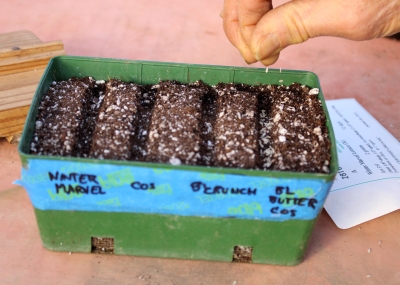 So I sowed them in a 4×6 inch seed flat filled with potting soil, then moved the flat in front of a sun-drenched, living room window. Once the lettuce seeds sprouted, which was in a few days, I moved them to the greenhouse. Warmer temperatures are needed to sprout a seed than to grow a plant.
So I sowed them in a 4×6 inch seed flat filled with potting soil, then moved the flat in front of a sun-drenched, living room window. Once the lettuce seeds sprouted, which was in a few days, I moved them to the greenhouse. Warmer temperatures are needed to sprout a seed than to grow a plant.
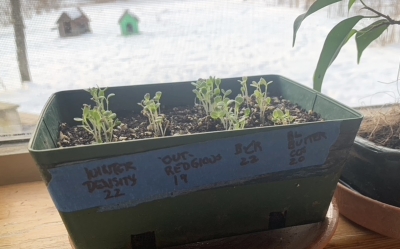
The seedlings should not, of course, remained crowded in their mini-furrows in the flat. So once the seedlings grow a little larger, I’ll gently lift each one by its leaves, coaxing it up and out of the flat, and then lower the roots into a dibbled hole in one potting-soil-filled-cell of GrowEase. And so on, until each of the 24 cells has a small plant in it.
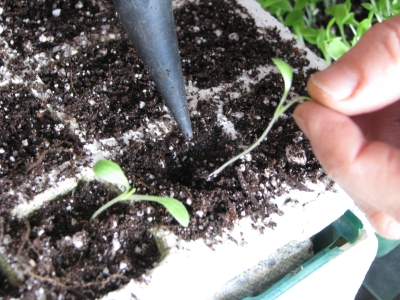 I use this same method to keep up a steady supply of lettuce and other seedlings all through summer, the plants typically needing about a month in the GrowEase before they’re ready to transplant into the ground. Not so in winter, with the sun still hanging low in the sky and greenhouse temperature still cool. I estimate that it won’t be until early March before the lettuces will be ready to plant in the ground in the greenhouse.
I use this same method to keep up a steady supply of lettuce and other seedlings all through summer, the plants typically needing about a month in the GrowEase before they’re ready to transplant into the ground. Not so in winter, with the sun still hanging low in the sky and greenhouse temperature still cool. I estimate that it won’t be until early March before the lettuces will be ready to plant in the ground in the greenhouse.
No matter; I’m hopeful, optimistic, and patient. And I’ll still be harvesting some of last autumn’s lettuce beyond that date.
LESS SALT IS BETTER
/15 Comments/in Soil/by Lee ReichWhat Does “Salt” Really Mean?
A few years back, one of my neighbors planted a hemlock hedge along the road in front of their house as a screen from the road. Sad to say, the future does not bode well for this planting. The hemlocks very likely will be damaged by road salt. And the prognosis is similar for those stately sugar maples that line so many streets.  Chemically, road salt — at least the more traditional “road salt” — is the same as the stuff in your salt shaker, sodium chloride. Either sodium or chloride ions can be toxic to plants. Chlorine is a nutrient needed by plants, but it is classed as a micronutrient, needed in minute quantities. Too much is toxic. Sodium is not at all needed by plants.
Chemically, road salt — at least the more traditional “road salt” — is the same as the stuff in your salt shaker, sodium chloride. Either sodium or chloride ions can be toxic to plants. Chlorine is a nutrient needed by plants, but it is classed as a micronutrient, needed in minute quantities. Too much is toxic. Sodium is not at all needed by plants.
In a broader sense, a “salt” is any ionic molecule, that is, a molecule of two or more atoms in which electrons, which are negatively charged, are donated from one atom to another. Who gets what depends on how easily an atom or atoms can lose one or more electrons and how hungry another atom or atoms is for those electrons. That ability to donate or be hungry for an electron depends on the number of positively charged protons in an atoms nucleus and the number and arrangement of electrons around the nucleus.
In the case of table salt, the sodium easily loses one electron and the chloride atom is hungry for it. The once neutral sodium atom becomes, after losing an electron, a positively charged sodium ion. The once neutral chloride atom, after gaining an electron, becomes a negatively charged chloride ion. And bingo, these two oppositely charged ions are strongly attracted to each other; they bond.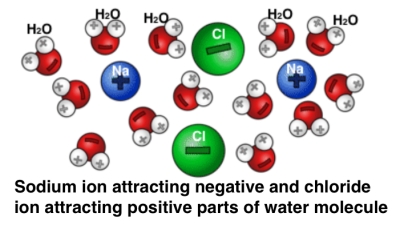 What happens when water enters the picture? A water molecule, because of its shape has a slightly imbalanced charge distribution. The negatively charged side of the water molecule gets attracted to the sodium ion of table salt, and the positively charged side of the water molecule gets attracted to the chloride ion.
What happens when water enters the picture? A water molecule, because of its shape has a slightly imbalanced charge distribution. The negatively charged side of the water molecule gets attracted to the sodium ion of table salt, and the positively charged side of the water molecule gets attracted to the chloride ion.
Salt Problem in Winter, and Beyond
Any salt (ionic molecule), not only sodium chloride, attracts water so will simulate drought if in excessive amounts in the soil in the same way that potato chips dry out your lips. This leads to common symptoms of salt injury. First evidence of salt injury is browning of leaves, starting along the leaf margins. Early fall coloration and defoliation also can occur. More severe injury is manifest by twig or branch dieback, or death of a whole plant.
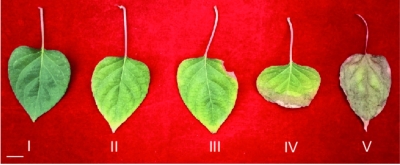
Progressive symptoms of salt damage
Salt also has an adverse effect on the soil itself, which is particularly insidious since it’s not as obvious as a dead plant. Over a period of time, sodium in salt can pull soil particles together, squeezing air out of the soil. As a result, roots suffocate.
Plants suffer most from salt in dry soils, so any plant exposed to salt in winter will benefit from mulching and watering during summer droughts. Watering also leaches sodium out of the soil, which improves soil porosity. Gypsum further aids in fluffing up a soil made too compact by sodium, by displacing sodium in the soil with calcium.
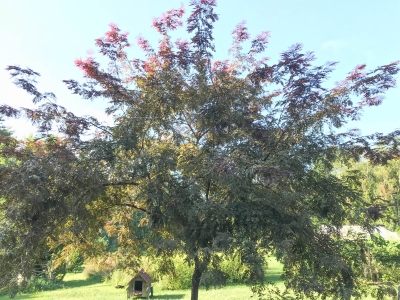
Honeylocust
Plants vary in their tolerance to salt. In addition to hemlock and sugar maple, the following trees and shrubs should not be planted where they will be exposed to salt: red maple, American hornbeam, shagbark hickory, dogwoods, winged euonymus, black walnut, privet, Douglas fir, white pine, crabapples, beech. Plants with a moderate tolerance to salt include: Amur maple, silver maple, boxelder, red or white cedar, lilac. Deciduous plants with high tolerances for salt include: Norway maple, paper and grey birches, Russian olive, honeylocust, white or red oaks, black locust, and many of the poplars and aspens.
For my neighbors who wanted an evergreen hedge, better choices would have been: white spruce, Colorado blue spruce, or Austrian pine. Perhaps even yew, since the site was somewhat shaded.
Mitigation or Avoidance
An obvious way to limit problems with road salt on plants, even salt that you might spread on your driveway or paths, is to use less salt, or none at all. (After once slipping on ice in my driveway and suffering a slight concussion, I became very aware of weighing damage to plants against damage to humans.) Fortunately, there are ways to keep all creatures happy.
Traction on ice or snow can be increased by spreading sand or sawdust.
A very effective technique, one that uses less salt, used by some road crews is to spray a salt solution on dry roads before a weather event that will bring slippery conditions.
When salt must be used, use a minimum amount or substitute a salt other than sodium chloride. Calcium chloride, for instance, is a salt that is only a tenth as toxic to plants as sodium chloride. One of the best materials as far as effectiveness with minimum damage to vehicles, concrete, and vegetation, is calcium magnesium acetate (CMA); but it’s expensive.
Salts that are fertilizers, such as ammonium nitrate or calcium nitrate, melt ice and at the same time nourish plants. Salts other than sodium chloride still need to be used with caution, for they can cause salt desiccation and/or nutrient imbalances in plants.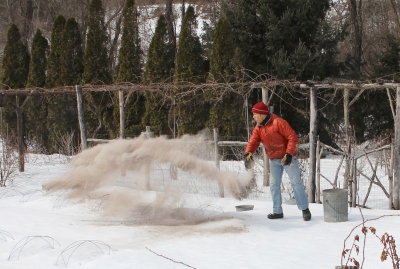 My favorite treatment for icy conditions here at home is spreading wood ash. Effectiveness comes from the dark color absorbing sunlight to speed melting, a slight grittiness increasing traction, and its salt content. Of course, access to wood ash means you or an ash-rich friend burns wood for heat.
My favorite treatment for icy conditions here at home is spreading wood ash. Effectiveness comes from the dark color absorbing sunlight to speed melting, a slight grittiness increasing traction, and its salt content. Of course, access to wood ash means you or an ash-rich friend burns wood for heat.
For all its benefits, wood ash is a mess if tracked indoors. I take off my shoes or boots in the mudroom.
THE BEST HERB FOR A NORTHERN WINTER
/27 Comments/in Design, Houseplants, Soil/by Lee ReichCalamity Avoidance
A horticultural calamity averted. Again. Deb was snipping some leaves from our potted rosemary “tree” for salad dressing and said she noticed that the plant looked a little wilty. I was skeptical. Rosemary leaves are so narrow and stiff that they hardly broadcast their thirst. Still, quite a few rosemary plants have succumbed to winter drought here.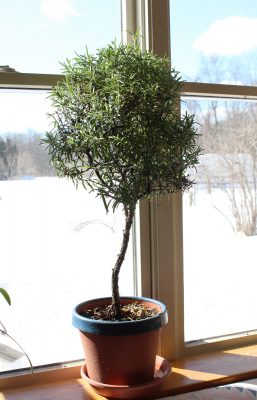
I checked the plant and, in fact, the leaves did look a bit wilty. The probe of my sort-of-accurate electronic moisture tester (which I nonetheless highly recommend) confirmed Deb’s diagnosis. The soil was very dry but, luckily, not to the point of killing the plant.
Allow me to digress . . . Soil scientists represent soil moisture levels with four descriptors. Right after a thorough watering, a soil is “saturated,” with all pores filled with water. Saturation is not desirable in the long term because roots need to “breathe” to do their work of drawing in nutrients and water, which is why plants exhibit the same symptoms from either dry or sodden soil.
Without additional water, gravity begins to pull water down and out of the larger pores of a saturated soil. Once gravity has pulled all the water it can from a soil, the soil is at “field capacity,” much to the pleasure of resident plants. At this point, large pores are filled with air yet some water, which is available for plants, is retained within smaller pores and clinging to soil particles.
Roots continue to slurp more and more water from the soil, but with increasing difficulty because water within even smaller pores and clinging even closer to soil particles is increasingly tightly held there by capillary attraction. Although the soil has moisture, it’s mostly inaccessible to plants. “Wilting point” has been reached.
Eventually, the only moisture left in the soil is that held very tightly in the very smallest pores and pressed tight against soil particles. That’s “permanent wilting point” from which, as the name implies, there’s no turning back. The plant will die.
The actual amount of water in a soil at any of these stages depends on the range of particle sizes in the soil. Clay soils have tiny particles, with tiny spaces between them, so have more water at wilting and permanent wilting point than do sandy soils, with their large particles and large pores.

At or near field capacity, sands have more air and less water than clays.
Where were we? Oh, my rosemary plant. I’m figuring it was just teetering on the edge of wilting point. Needless to say, I watered both my rosemary “trees.”
(For a lot more about soil water and how to make the best of it, see my book The Ever Curious Gardener: Using a Little Natural Science for a Much Better Garden.)
Dry Air, Moist (Enough) Soil
You’d think — I once did — that rosemary, because in the wild it billows down dry hillsides overlooking the Mediterranean, would be resistant to drought. It does tolerate dry air. But those wild plants’ roots are in the ground where they can forage far and wide for moisture; not so in a pot.
Also, my rosemary plants are coddled with relatively consistent warmth in winter and a potting mix rich in nutrients. Couple this with low light conditions, even near a south-facing window, and you get very succulent growth. I don’t know what rosemary plants growing on a Grecian hillside are doing now, but my plants are growing like gangbusters. All that succulent growth transpires lots of water, and is very susceptible to drought.
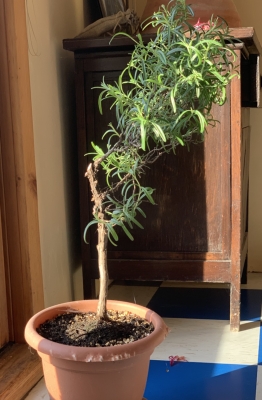
Left half of this rosemary expired last summer
Once my plants go outdoors in summer, their leaves mature and toughen and growth is less succulent. They do still need sufficient moisture, so I have drip tubes on a timer quenching their thirst (and that of other plants). Except, that is, when the timer’s battery needs replacing and I don’t notice it. That was last summer. The plants were not at the permanent wilting point but a number of branches, which I pruned off, dried up, dead.
In Praise of Potted Rosemary
All this is not to frown upon growing rosemary where it can’t survive winters outdoors. On the contrary, I consider rosemary to be the finest herb for indoor growing. Flavorwise, it packs a powerful punch, unlike chives, for example, a plant that needs to be practically decimated if you really want to flavor something with it. Merely brushing against my rosemary plant releases an aromatic, piney cloud.
Rosemary is also a very attractive houseplant whether grown as a scraggly shrub reminiscent of the wild plants in their native haunts, trained as dense cones, or — as are my plants — as miniature trees. The leaves retain a healthy, verdant look, unlike those of basil, which look sickly and out of their element in dry, relatively dark and cool homes in winter.
Rosemary also rarely suffers from any insect or disease problem.
And finally, properly cared for, rosemary is perennial so can provide aroma, flavor, and beauty for many, many years.
But you and I do need to pay close attention to watering.
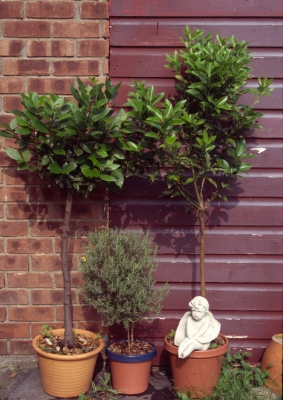
Rosemary, with its compatriots, bay and citrus, in summer

